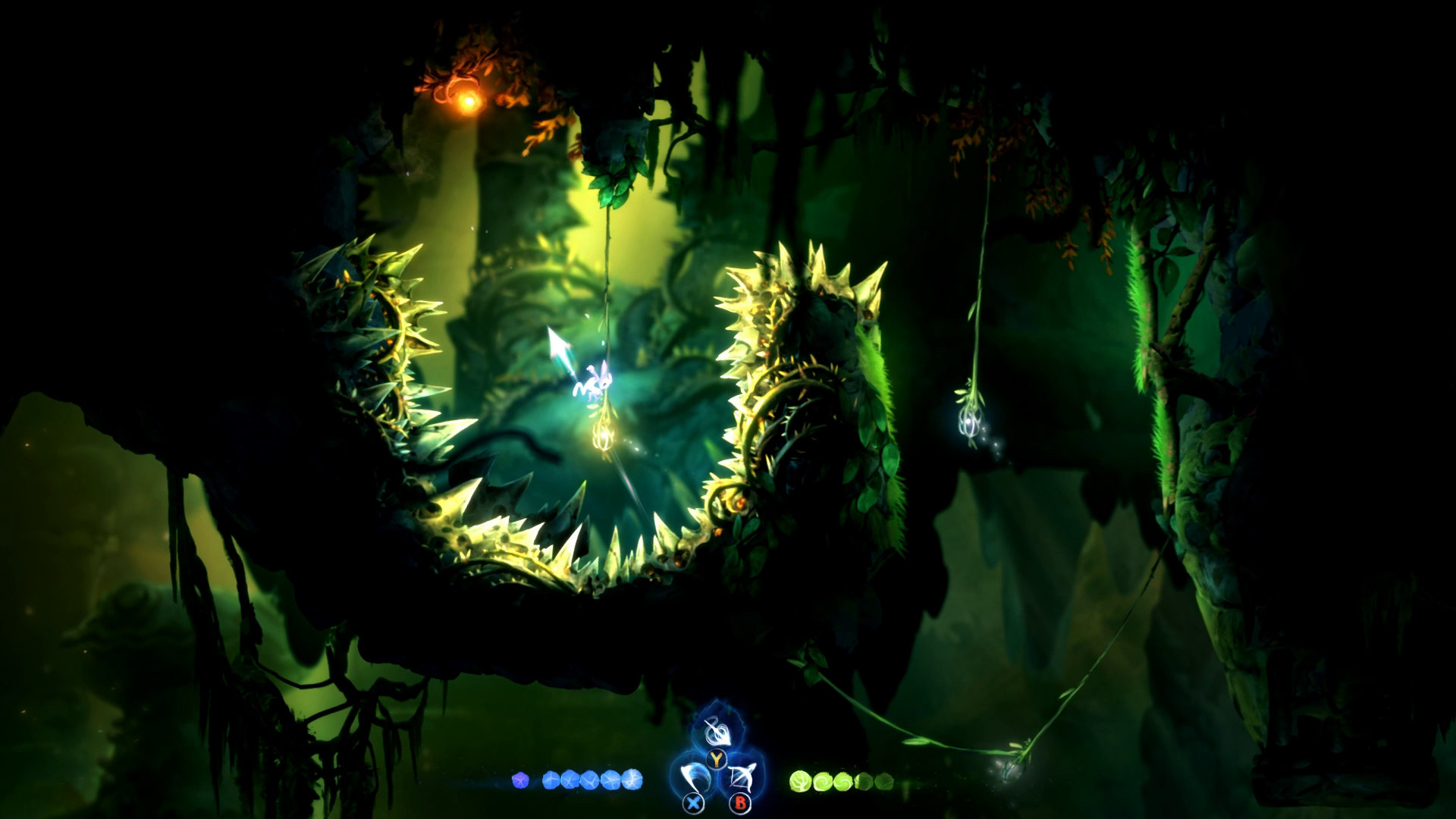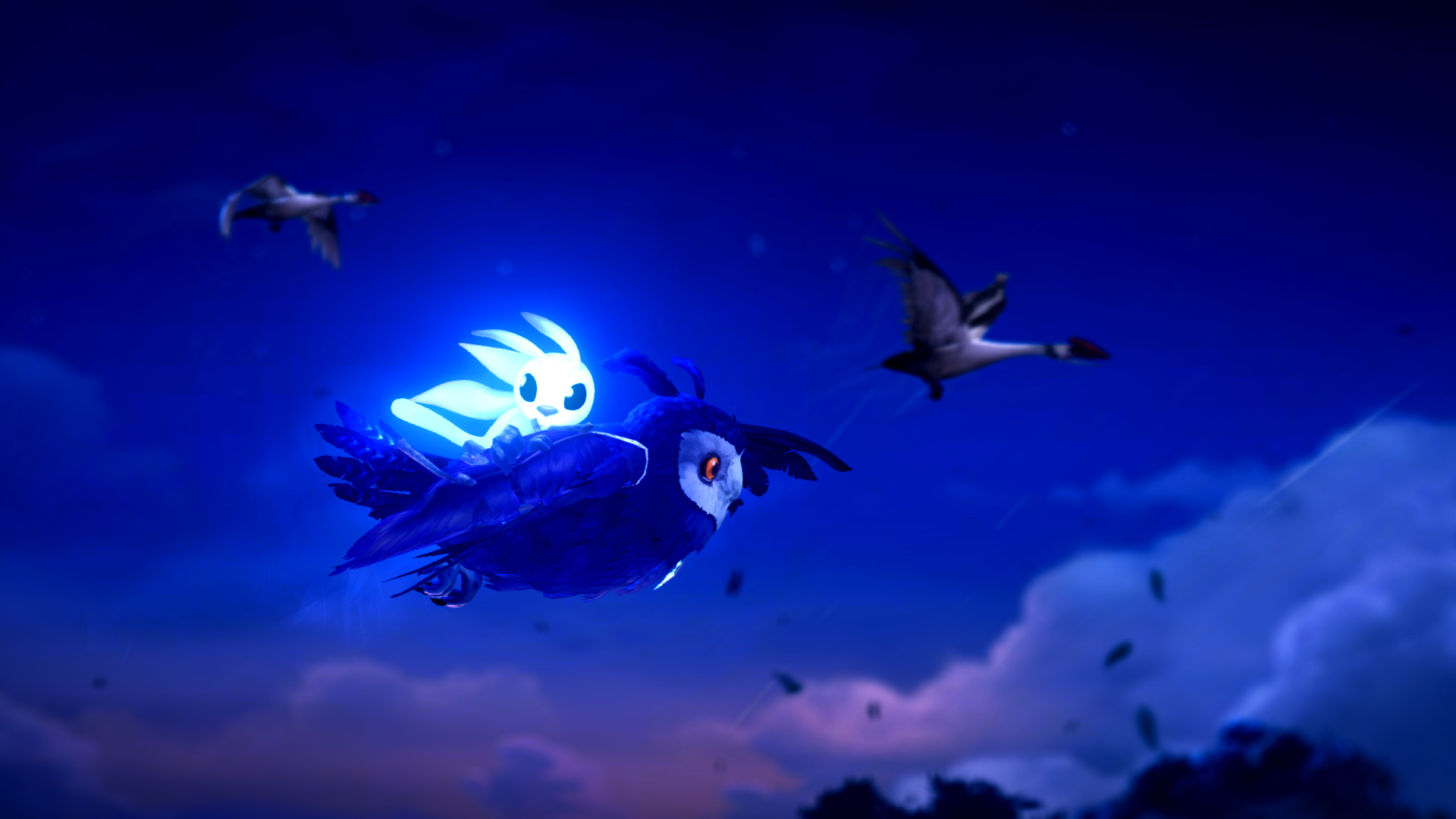Our Verdict
It's inconsistent and sometimes annoying, but ultimately a charming, challenging, heart-string-pulling fable.
PC Gamer's got your back
What is it? A giant 2D world full of abilities to unlock, tricky platforming segments, puzzles, and boss fights.
Expect to pay: $30/£25
Developer: Moon Studios
Publisher: Xbox Game Studios
Reviewed on: Windows 10, Core i7-6700K, 16GB RAM, GeForce GTX 980
Multiplayer: None
Link: orithegame.com
As charming and fun as it often was, there was something off about my entire 15-hour playthrough of Ori and the Will of the Wisps. I wasn't sure what it was at first, but it was this: I had to walk directly over health and energy orbs to pick them up. Orbs land in all kinds of inconvenient places, scattering into traps and pits and beneath bulbous spider boss asses, and so it felt unnaturally restrictive. What kind of 2D metroidvania character can't vacuum up orbs from a distance?
In hindsight, the orb magnetism ability that I missed in my first playthrough was not hard to find behind its breakable wall near the beginning of the game. In my defense, I hadn't expected anything so fundamental to be hidden in the tutorial area, where everything else was unmissable. Nothing on my map indicated that I'd missed anything, and so I played the whole game without a very useful ability. Oops.

Bigger and messier
Other inconsistencies and quirks rankled me throughout Will of the Wisps. It's much bigger and more complex than the five-year-old Ori and the Blind Forest, and, perhaps as a result, it's a messier blend of combat, exploration, and platforming—amazing fun at times, and gorgeous all over, but sloppy.
For instance, the new autosave system works fine most of the time, except sometimes when it doesn't save where I expect it to and I'm sent back a frustrating distance. I wound up peeking at the corner of the screen after every tricky bit of platforming to make sure the little rotating save icon appeared. And in a couple of spots, it respawned me in places that were impossible to escape, so it's a good thing I could quit to the menu and load a backup save.
The simple combat of Ori and the Blind Forest has been expanded, but it's not much fun. Enemies easily charge through Ori's light sword combos—hits don't interrupt them—and so I had to squint past my swings to gauge when I should leap out of the way. It can be a headache given how small Ori is, and how many bits of waving organic matter in the air and background provide visual interference.
When I could, I just cheesed enemies by leaping above them and repeatedly throwing downward strikes, which kept me hovering above their heads. But bugs with impenetrable shells have to be tricked into running into walls and dazing themselves—a tiring old enemy type—and there's also no way to cheese the annoying-ass mosquitoes that spawn until you destroy their nest. Some enemies are just mines that sit on walls and blow up when you get near them, and it's not as if the explosions propel you away from the wall or anything—they're just there to be annoying.
I beat Will of the Wisps on the normal difficulty mode, which is the way it's "meant" to be played according to the menu, but I started it again on easy and definitely prefer playing it the way it's not meant to be played. Fighting the same handful of enemy types for ten-plus hours is not what makes Ori fun, so taking less damage and vaporizing all the crawling things with fewer swings makes everything a little better.

The run is mightier...
You can't always skip combat, but when you can I bet you will, because it's so much more fun to zip through the air. The basic jumping, double-jumping, and dashing is precise and satisfying, just like it was in Ori and the Blind Forest, and the abilities that made that game so fun are back. You can launch glowing energy rope at hooks and sling yourself into the air, chaining grapples like Spider-Man. You can freeze time when you're next to a projectile and then launch it and yourself in opposite directions, bouncing between glowing bullets as if you're ricocheting off of them. There are plenty of places to stop and rest, but you rarely have to give up any speed if you don't want to.
With 10 unique areas, there are a ton of special movement abilities and puzzle types, some more successful than others. Diving into sand pits and bouncing around like a pinball before shooting back out like a Dune worm is brilliant. The bits that take after Portal, meanwhile, are a little disappointing. They don't play much with momentum—for the most part, you just go in one magic blue hole and out another—and the most complicated it gets is a tedious puzzle in which you have to methodically guide a projectile between portal pairs.
Even the bits that are only so-so feel great to clear, though—like flawlessly running through an ultra-hard Guitar Hero song.

Aside from that good feeling, the reward for platforming victory doesn't have to be anything more than seeing what's next. I wish I could pluck some of the landscapes out Will of the Wisps and frame them, looping animations included. From the swamps to the mountains and the obligatory water level, they're all stunning—full of light and air and life.
The characters and their stories kept me going as well. Like Ori and the Blind Forest, Will of the Wisps is on a mission to pull both delighted and sad awws out of even the most determined grumps—and it does a better job of it. Ori is joined for a brief section by Ku, an owlet who hatches at the end of the last game, and whose curious and sad eyes are just so goddamn cute I almost resent them for manipulating me.
Not quite as cute but also fun are the Moki, creatures that look a bit like meerkats and pop out of the scenery to comment on Ori's journey, offer advice, and ask for help. Moki and other characters congregate in a growing village as Ori restores the forest, and little sidequests can be done to help them out. I found growing their little town and taking on their little tasks—like acquiring a hat for one and some soup for another—to be genuinely motivating. It also relaxes the pace a little, which helps counterbalance the frustrating bits.

Boss battler
The broader plot is standard forest spirit mysticism stuff—restore the light, restore the balance—and there's another nasty-but-sympathetic owl villain. The end may induce sniffling, but its success will depend on whether or not the boss fights and escape sequences have put you in a sour mood by the time you get to it.
The move-or-die escape scenes, in which you have to jump, dash, float, and grapple through collapsing structures while making zero mistakes—there are no checkpoints—are seriously annoying in places. There's a visually-confusing section near the end of one, and I had to replay the whole sequence several times to figure it out, letting myself die so that I could try to observe what I was meant to do. It's satisfying to clear these challenges, but in the same way it would be satisfying to stop punching yourself.

There are multi-stage boss fights, too—the kind with a big life bar that you have to chip away at—and they can also be frustrating. The escape sequences at least rely on the unbroken chaining of forward motion that makes Ori feel great, whereas the fights have you leaping around enclosed spaces trying to get sword whacks and ranged attacks in when you can.
Take the whole thing at a relaxed pace, though, and you'll collect lots of spirit money with which to upgrade Ori's abilities, reducing incoming damage and increasing outgoing damage. Hunting down energy and life cells throughout the world also makes things easier, so that if a boss is frustrating, at least you can go away and improve the math in your favor. And at least the boss stages are no less beautiful than the rest of the game—and also full of bitter-sweetness.
I prefer Ori and the Blind Forest for its compactness and simplicity, but Ori and the Will of the Wisps is also worth playing to the end. It trips over its complexity at times, and really doesn't need so much combat, but it's gorgeous, funny, and the triple-jumping could go on forever without getting old.
It's inconsistent and sometimes annoying, but ultimately a charming, challenging, heart-string-pulling fable.

Tyler grew up in Silicon Valley during the '80s and '90s, playing games like Zork and Arkanoid on early PCs. He was later captivated by Myst, SimCity, Civilization, Command & Conquer, all the shooters they call "boomer shooters" now, and PS1 classic Bushido Blade (that's right: he had Bleem!). Tyler joined PC Gamer in 2011, and today he's focused on the site's news coverage. His hobbies include amateur boxing and adding to his 1,200-plus hours in Rocket League.


